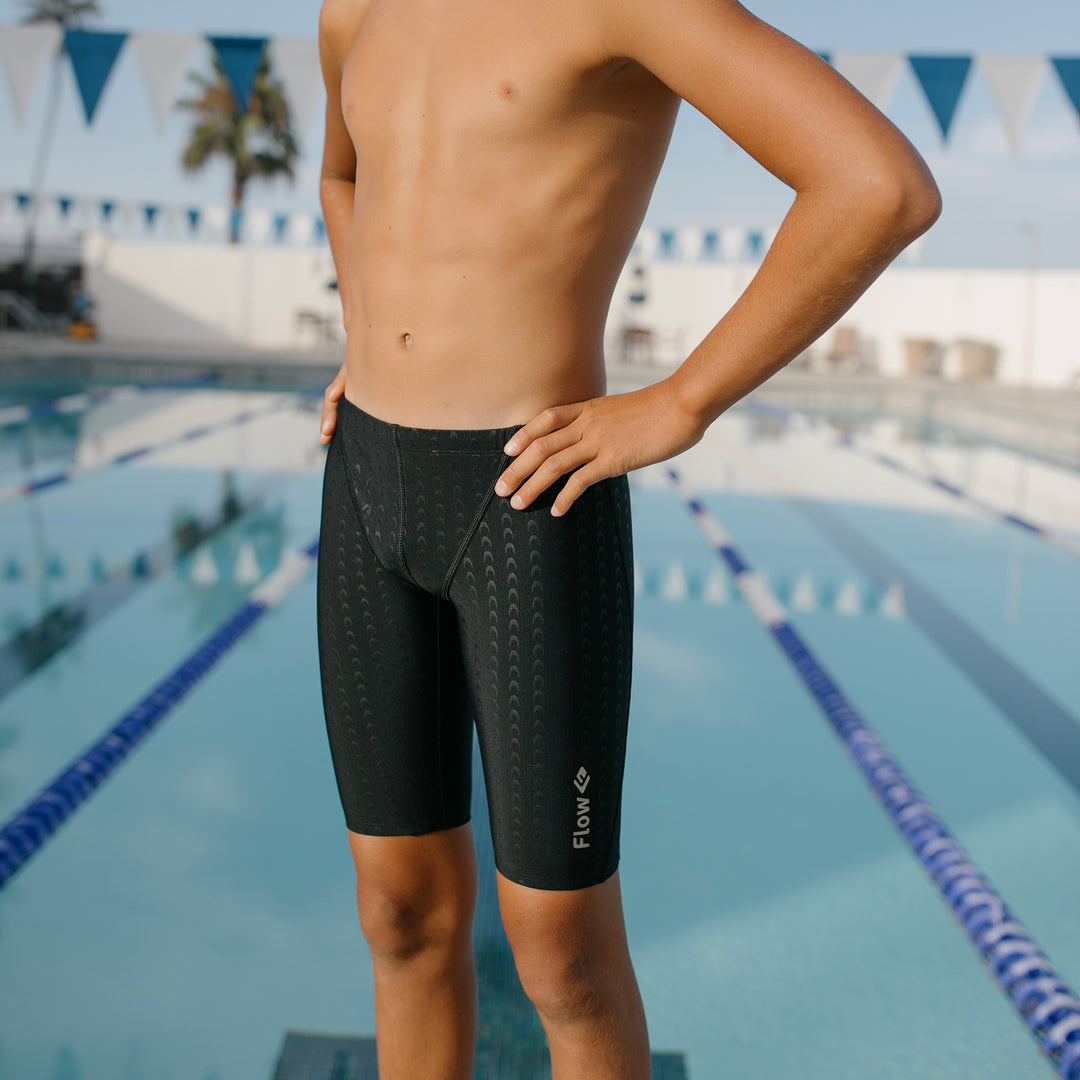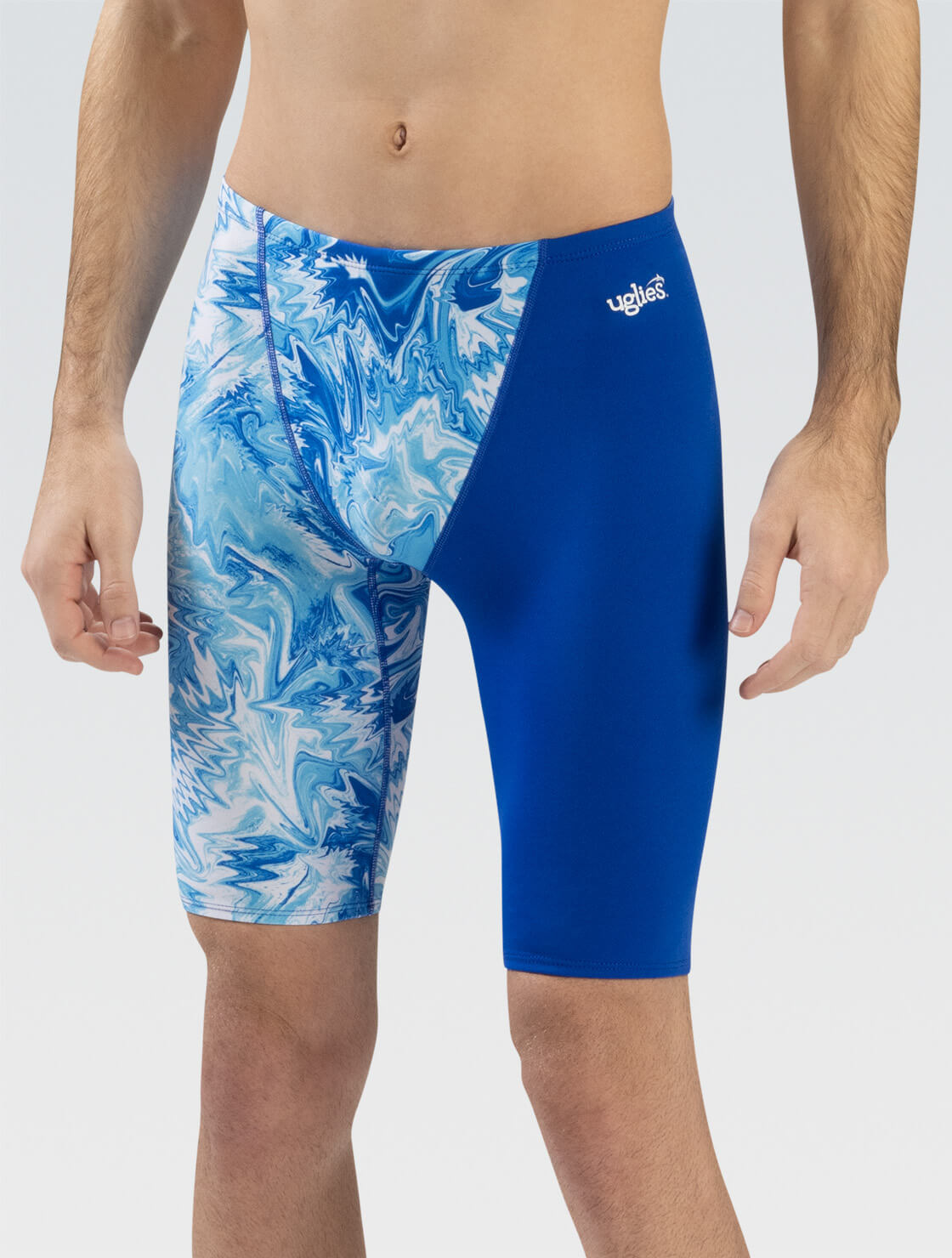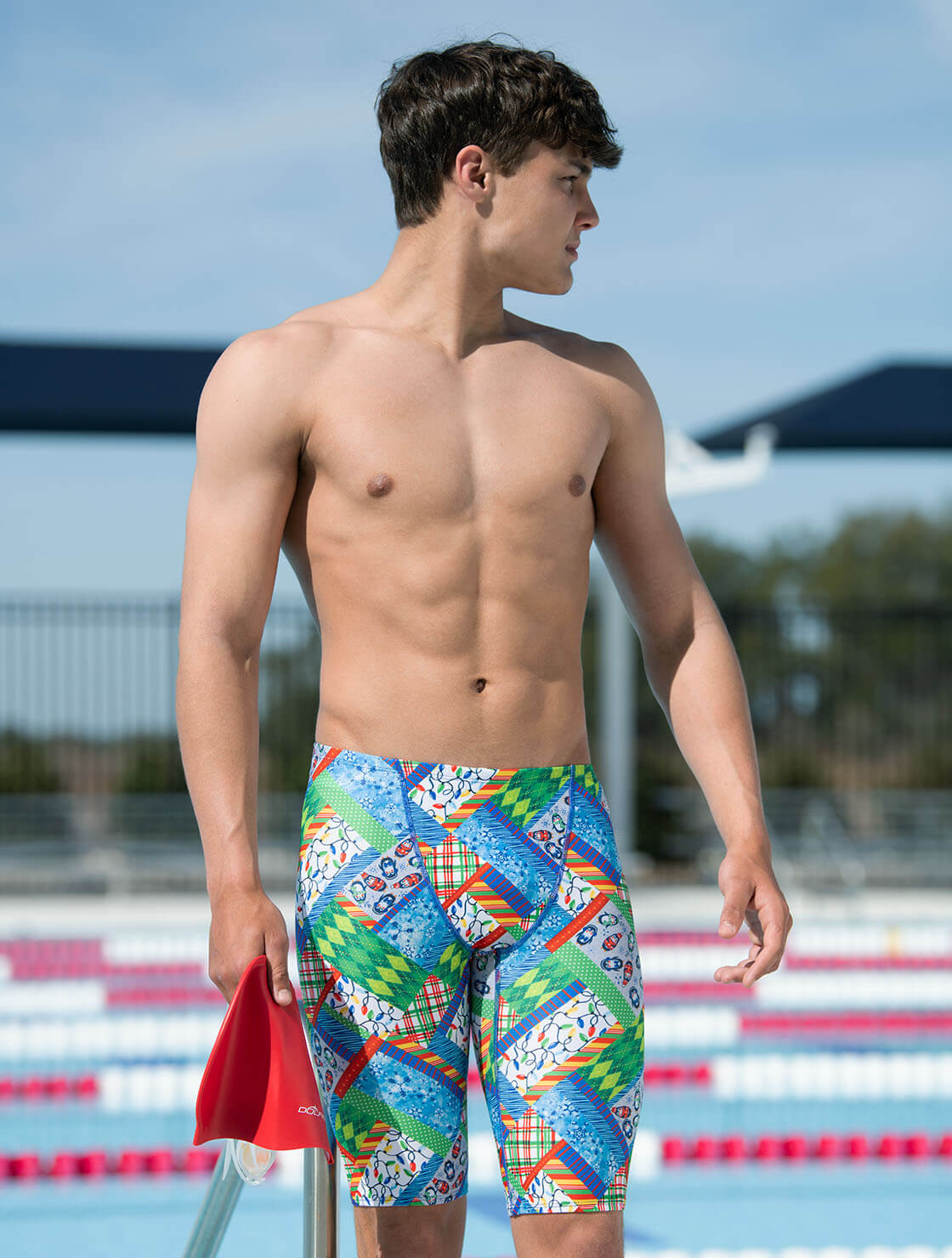Content Menu
● Definition and Design
● Hydrodynamics and Performance
● Muscle Compression and Recovery
● Comfort and Confidence
● Materials and Technology
● Sizing and Fit
● Competitive Use
● Care and Maintenance
● Comparison with Other Swimwear
● Evolution of Jammer Technology
● Environmental Considerations
● Choosing the Right Jammer
● Future of Jammer Technology
● Conclusion
● Frequently Asked Questions
>> 1. Q: How long do jammers typically last?
>> 2. Q: Can jammers be worn for activities other than swimming?
>> 3. Q: Are there different types of jammers for different swimming strokes?
>> 4. Q: How tight should a jammer fit?
>> 5. Q: Can women wear jammers?
● Citations:
Jammer swimwear has become an essential part of competitive swimming, offering athletes a blend of performance, comfort, and hydrodynamic efficiency. This article delves into the world of jammer swimwear, exploring its design, benefits, and impact on the sport of swimming.

Definition and Design
Jammers are a type of swimwear for men that closely resemble cycling shorts. They are knee-length, form-fitting, and made from water-resistant fabric that compresses key muscle groups[1]. Unlike traditional swim trunks, which can be loose and baggy, jammers are designed to mold to the swimmer's body, providing a sleek, streamlined silhouette[1].
Jammer Swimwear
The construction of jammers is critical to their functionality. They are typically made with flatlock stitching to prevent chafing and irritation on the skin. An elastic waistband and drawstring ensure a snug fit and prevent slipping during a swim[2]. Most jammers are made from a combination of polyester and PBT (polybutylene terephthalate), though some high-end versions are constructed from nylon and Lycra blends[1].
Hydrodynamics and Performance
The primary reason swimmers choose jammers is their hydrodynamic advantage. Traditional men's swimwear can act like a parachute, catching water and creating significant drag. Jammers, with their tight, body-hugging fit and streamlined design, do not trap water. Instead, they repel it, mimicking the sleekness of marine animals[1].
This efficiency in water movement can shave precious milliseconds off a race time, often making the difference between winning and losing. Jammers help swimmers maintain a more horizontal position in the water, reducing resistance and maximizing forward motion[1].
Video: Speedo Fastskin3 Jammer Fitting Guide Presented by ProSwimwear
Muscle Compression and Recovery
Another significant benefit of jammer swimwear is muscle compression. The material of jammers provides gentle, consistent pressure on the muscles, increasing circulation and reducing lactic acid build-up[1]. This compression helps to stabilize muscles, reducing long-term fatigue and potentially improving performance in the final laps of a race.
Additionally, the pressure helps to flush out lactic acid, reducing muscle soreness and speeding up recovery times. This aspect is crucial during multi-day competitions, allowing swimmers to perform at their best throughout an event[1].
Muscle Compression Diagram
Comfort and Confidence
The psychological aspect of wearing jammers shouldn't be overlooked. Feeling comfortable and confident in swimwear can significantly impact a swimmer's performance. Loose, baggy swimwear can lead to distractions and insecurities[1].
Jammers solve this issue by providing a secure fit that doesn't shift during dives or turns. They also offer modest coverage, which adds a level of comfort for many athletes. Moreover, knowing they are equipped with attire designed for speed and efficiency can provide swimmers with a mental edge, vital in a sport where psychological factors can profoundly influence physical performance[1].

Materials and Technology
Most jammers are made from a combination of polyester and PBT (polybutylene terephthalate). These materials are chosen for their ability to resist chlorine degradation, hold shape, and, most importantly, reduce friction in the water[1]. High-end versions may use nylon and Lycra blends for enhanced performance.
Some advanced jammers incorporate technologies inspired by shark skin, designed to further reduce drag and improve hydrodynamics. These suits often feature special textures or patterns on the fabric surface to manipulate water flow around the swimmer's body.
Jammer Material Close-up
Sizing and Fit
Proper sizing is crucial for jammer swimwear to function effectively. A well-fitted jammer should have a tight, compressive feel and take time to put on. It typically takes about 10 to 20 minutes to properly don a high-performance jammer[4].
To find the right size, swimmers should measure their waist and hips. The hip measurement is particularly important and should be taken in line with the hip bone. For the waist, measure around the waistline six centimeters below the belly button[4].
Video: How to put on your jammer Elite suit.
Competitive Use
Jammers are widely used in competitive swimming due to their performance benefits. Many swimming federations, including FINA (Fédération Internationale de Natation), have specific regulations regarding the use of jammers in competitions.
For instance, FINA-approved jammers are available, which are made specifically for racing and meet all the necessary regulations. These suits often incorporate advanced technologies and materials to provide the maximum allowable advantage within the rules of the sport.
Competitive Swimmer in Jammers
Care and Maintenance
Proper care of jammer swimwear is essential to maintain its performance and longevity. After each use, jammers should be rinsed in cold, clean water. Hot water can damage the fabric and reduce the suit's lifespan[6].
It's also important to avoid wringing out the suit, as this can stretch and damage the fibers. Instead, gently squeeze out excess water and lay the suit flat to dry away from direct sunlight. Avoid using fabric softeners or bleach when washing jammers, as these can break down the technical fabrics.

Comparison with Other Swimwear
When compared to other types of men's swimwear, jammers offer a unique combination of coverage and performance. Unlike swim briefs (often called "Speedos"), jammers provide more coverage, which some swimmers find more comfortable. However, they still offer the hydrodynamic benefits that loose swim trunks or board shorts lack[3].
Here's a comparison table of different types of men's swimwear:
| Feature | Jammers | Swim Briefs | Swim Trunks | Board Shorts |
| Length | Knee-length | Hip-level | Mid-thigh to knee | Knee or below |
| Fit | Tight, compressive | Tight | Loose | Loose |
| Drag Reduction | High | High | Low | Low |
| Coverage | Moderate | Minimal | Moderate | High |
| Competitive Use | Common | Common | Rare | Rare |
Evolution of Jammer Technology
The technology behind jammer swimwear has evolved significantly since its introduction. Early jammers were simply longer versions of traditional swim briefs, but modern versions incorporate advanced materials and designs to enhance performance.
Some of the latest innovations in jammer technology include:
1. Bonded seams: These reduce drag by eliminating raised stitching.
2. Water-repellent coatings: These help the swimmer glide through the water more efficiently.
3. Compression panels: Strategically placed panels provide targeted muscle support.
4. Flexible fabrics: These allow for a full range of motion without compromising the suit's compressive properties.

Environmental Considerations
As sustainability becomes an increasingly important consideration in all industries, swimwear manufacturers are also making efforts to produce more environmentally friendly jammers. Some companies now offer jammers made from recycled materials, such as plastic bottles recovered from the ocean[9].
These eco-friendly options often maintain the same performance characteristics as traditional jammers while reducing the environmental impact of production. As technology advances, we can expect to see more sustainable options in the jammer market.
Choosing the Right Jammer
Selecting the right jammer depends on several factors, including the swimmer's body type, swimming style, and intended use. For competitive swimmers, a high-end, FINA-approved jammer might be the best choice. For recreational swimmers or those just starting out, a more budget-friendly option could suffice.
When choosing a jammer, consider the following:
1. Fit: Ensure the jammer fits snugly but not so tight that it restricts movement.
2. Material: Look for durable, chlorine-resistant fabrics for longevity.
3. Purpose: Determine whether you need a jammer for training, competition, or both.
4. Brand reputation: Established brands often offer reliable quality and performance.
Remember, the most expensive jammer isn't always the best choice for every swimmer. It's important to find a balance between performance, comfort, and budget.

Future of Jammer Technology
As swimming technology continues to advance, we can expect to see further innovations in jammer design. Future developments might include:
1. Smart fabrics: Jammers that can monitor the swimmer's performance and provide real-time feedback.
2. Biomimetic designs: Suits that more closely mimic the hydrodynamic properties of marine animals.
3. Customization: 3D-printed jammers tailored to an individual swimmer's body shape and swimming style.
4. Sustainable materials: More environmentally friendly options that maintain high performance.
The future of jammer technology is exciting, with potential advancements that could further revolutionize competitive swimming.
Conclusion
Jammer swimwear has become an integral part of competitive swimming, offering a blend of performance enhancement, comfort, and hydrodynamic efficiency. From their form-fitting design to advanced materials and technologies, jammers provide swimmers with a significant advantage in the water.
As the sport of swimming continues to evolve, so too will the technology behind jammer swimwear. Whether you're a competitive swimmer looking to shave seconds off your time or a recreational swimmer seeking comfort and performance, understanding the features and benefits of jammers can help you make an informed choice about your swimwear.
Frequently Asked Questions
1. Q: How long do jammers typically last?
A: With proper care, a high-quality jammer can last for about 30-40 swim sessions or one swimming season. However, this can vary depending on usage frequency and care practices.
2. Q: Can jammers be worn for activities other than swimming?
A: While designed primarily for swimming, jammers can be worn for other water sports or activities that require a snug, hydrodynamic fit, such as water polo or triathlon swimming.
3. Q: Are there different types of jammers for different swimming strokes?
A: While most jammers are suitable for all strokes, some high-end models may be optimized for specific strokes or distances. However, these differences are usually subtle and may not be noticeable to recreational swimmers.
4. Q: How tight should a jammer fit?
A: A jammer should fit snugly against the skin without restricting movement or circulation. It should take some effort to put on but shouldn't be painful or uncomfortable once in place.
5. Q: Can women wear jammers?
A: While jammers are typically marketed towards men, some women, particularly those who prefer more coverage or compete in triathlons, choose to wear jammers. However, most competitive female swimmers opt for women-specific swimsuits.

Citations:
[1] https://reddiset.com/blogs/articles/why-do-swimmers-wear-jammers
[2] https://www.speedo.co.za/jammers-vs-briefs-blog
[3] https://www.220triathlon.com/gear/swim/swim-clothing/what-is-the-difference-between-swim-trunks-and-jammers
[4] https://www.youtube.com/watch?v=iHQ67oh2LvI
[5] https://www.everyoneactive.com/content-hub/swimming/swim-shorts/
[6] https://wanderingswimmer.com/mens-jammer/
[7] https://www.reddit.com/r/Swimming/comments/16y9lh1/why_are_jammers_called_jammers/
[8] https://www.youtube.com/watch?v=WsE_R1RxTv4
[9] https://www.arenasport.com/en_row/004770-men-s-team-swim-jammer-solid.html
[10] https://www.youtube.com/watch?v=54nIwWqcFic







































